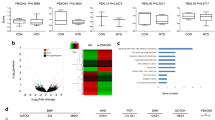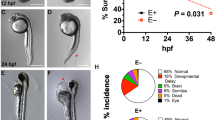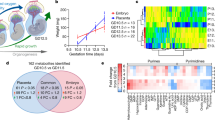Abstract
A number of studies have suggested that the active derivative of vitamin A, retinoic acid (RA), may be important for early development of mammalian embryos1,2. Severe vitamin A deprivation in rodents results in maternal infertility3, precluding a thorough investigation of the role of RA during embryogenesis. Here we show that production of RA by the retinaldehyde dehydrogenase-2 (Raldh2) enzyme4,5 is required for mouse embryo survival and early morphogenesis. Raldh2 is an NAD-dependent aldehyde dehydrogenase with high substrate specificity for retinaldehyde4,5. Its pattern of expression during mouse development has suggested that it may be responsible for embryonic RA synthesis4,6. We generated a targeted disruption of the mouse Raldh2 gene and found that Raldh2–/– embryos, which die at midgestation without undergoing axial rotation (body turning), exhibit shortening along the anterioposterior axis and do not form limb buds. Their heart consists of a single, medial, dilated cavity. Their frontonasal region is truncated and their otocysts are severely reduced. These defects result from a block in embryonic RA synthesis, as shown by the lack of activity of RA-responsive transgenes, the altered expression of an RA-target homeobox gene and the near full rescue of the mutant phenotype by maternal RA administration. Our data establish that RA synthesized by the post-implantation mammalian embryo is an essential developmental hormone whose lack leads to early embryo death.
This is a preview of subscription content, access via your institution
Access options
Subscribe to this journal
Receive 12 print issues and online access
$209.00 per year
only $17.42 per issue
Buy this article
- Purchase on Springer Link
- Instant access to full article PDF
Prices may be subject to local taxes which are calculated during checkout





Similar content being viewed by others
References
Conlon, R.A. Retinoic acid and pattern formation in vertebrates. Trends Genet. 11, 314–319 ( 1995).
Kastner, P., Mark, M. & Chambon, P. Nonsteroid nuclear receptors: what are genetic studies telling us about their role in real life? Cell 83, 859–869 (1995).
Dickman, E.D., Thaller, C. & Smith, S.M. Temporally-regulated retinoic acid depletion produces specific neural crest, ocular and nervous system defects. Development 124, 3111–3121 ( 1997).
Zhao, D. et al. Molecular identification of a major retinoic-acid synthesizing enzyme: a retinaldehyde-specific dehydrogenase. Eur. J. Biochem. 240, 15–22 (1996).
Wang, X., Penzes, P. & Napoli, J.L. Cloning of a cDNA encoding an aldehyde dehydrogenase and its expression in E. coli. J. Biol. Chem. 271, 16288–16293 (1996).
Niederreither, K., McCaffery, P., Dräger, U.C., Chambon, P. & Dollé, P. Restricted expression and retinoic acid-induced downregulation of the retinaldehyde dehydrogenase type 2 (RALDH-2) gene during mouse development. Mech. Dev. 62, 67–78 (1997).
Olson, E.N. & Srivastava, D. Molecular pathways controlling heart development. Science 272, 671– 676 (1996).
Represa, J., Leon, Y., Miner, C. & Giraldez, F. The int-2 proto-oncogene is responsible for induction of the inner ear. Nature 353, 561–563 ( 1991).
Martin, G.R. The roles of FGFs in the early development of vertebrate limbs. Genes Dev. 12, 1571–1586 (1998).
Biben, C. & Harvey, R. Homeodomain factor Nkx2-5 controls left/right asymmetric expression of bHLH gene eHand during murine heart development. Genes Dev. 11, 1357– 1369 (1997).
Twal, W., Roze, L. & Zile, M.H. Anti-retinoic acid monoclonal antibody localizes all- trans-retinoic acid in target cells and blocks normal development in early quail embryos. Dev. Biol. 168, 225– 234 (1995).
Rossant, J., Zirnbigl, R., Cado, D., Shago, M. & Giguère, V. Expression of a retinoic acid response element-hsplacZ transgene defines specific domains of transcriptional activity during mouse embryogenesis. Genes Dev. 5, 1333– 1344 (1991).
Mendelsohn, C., Ruberte, E., LeMeur, M., Morriss-Kay, G. & Chambon, P. Developmental analysis of the retinoic acid-inducible RAR-β2 promoter in trangenic animals. Development 113, 723–734 (1991).
McCaffery, P., Posch, K.C., Napoli, J.L., Gudas, L.J. & Dräger, U.C. Changing patterns of the retinoic acid system in the developing retina. Dev. Biol. 158 , 390–399 (1993).
Ang, H.L. & Duester, G. Initiation of retinoid signaling in primitive streak mouse embryos: spatiotemporal expression patterns of receptors and metabolic enzymes for ligand synthesis. Dev. Dyn. 208, 536-543 (1997).
Moss, J.B. et al. Dynamic patterns of retinoic acid synthesis and response in the developing mammalian heart. Dev. Biol. 199, 55–71 (1998).
Langston, A.W. & Gudas, L.J. Identification of a retinoic acid responsive enhancer 3´ of the murine homeobox gene Hox-1.6. Mech. Dev. 38, 217– 227 (1992).
Dupé, V. et al. In vivo functional analysis of the Hoxa-1 3´ retinoic acid response element (3´RARE). Development 124, 339–410 (1997).
Ang, S.L., Conlon, R.A., Jin, O. & Rossant, J. Positive and negative signals from mesoderm regulate the expression of mouse Otx2 in ectoderm explants. Development 120, 2979– 2989 (1994).
Simeone, A. et al. Retinoic acid induces stage-specific antero-posterior transformation of rostral central nervous system. Mech. Dev. 51, 83–98 (1995).
Chen, Y.P., Huang, L., Russo, A.F. & Solursh, M. Retinoic acid is enriched in Hensen's node and is developmentally regulated in the early chick embryo. Proc. Natl Acad. Sci. USA 89, 10056–10059 (1992).
Hogan, B.L., Thaller, C. & Eichele, G. Evidence that Hensen's node is a site of retinoic acid synthesis. Nature 359, 237– 241 (1992).
Ang, H.L., Deltour, L., Hayamizu, T.F., Zgombic-Knight, M. & Duester, G. Retinoic acid synthesis in mouse embryos during gastrulation and craniofacial development linked to class IV alcohol dehydrogenase gene expression. J. Biol. Chem. 271, 9526–9534 (1996).
Blumberg, B. An essential role for retinoid signaling in anteroposterior neural specification and neuronal differentiation. Semin. Cell Dev. Biol. 8, 417–428 (1997).
Beddington, R.S.P. & Robertson, E.J. Anterior patterning in mouse. Trends Genet. 14, 277– 284 (1998).
Maden, M., Sonneveld, E., van der Saag, P.T. & Gale, E. The distribution of endogenous retinoic acid in the chick embryo: implications for developmental mechanisms. Development 125, 4133–4144 (1998).
Dierich, A. & Dollé, P. Gene targeting in embryonic stem cells. in Methods in Developmental Toxicology and Biology (eds Klug, S. & Thiel, R.) 111-123 (Blackwell Science, Oxford,1997).
Décimo, D., Georges-Labouesse, E. & Dollé, P. In situ hybridization of nucleic acid probes to cellular RNA. in Gene Probes 2–A Practical Approach (eds Hames, B.D. & Higgins, S.J.) 183-266 (Oxford University Press, Oxford, 1995).
Neela, J. & Raman, L. The relationship between maternal nutritional status and spontaneous abortion. Natl Med. J. India 10, 15–16 ( 1997).
Acknowledgements
We thank A. Dierich and M. Le Meur for supervising ES cell and animal facility work; N. Messadeq for the scanning electron micrographs; B. Schuhbaur and V.Fraulob for technical assistance; J. Rossant for providing RAREhsplacZ mice; and S.L. Ang (Otx2), P. Bouillet (Meox1), G. Gradwohl (Hand1), J. Grippo (Hoxa1), B. Herrmann (T), B. Hogan (Fgf10), A.P. McMahon (Fgf3) and G. Martin (Fgf8) for in situ hybridization probes. This work was supported by funds from the Centre National de la Recherche Scientifique, the Institut National de la Santé et de la Recherche Médicale, the Collège de France, the Hôpitaux Universitaires de Strasbourg, the Association pour la Recherche sur le Cancer, the Fondation pour la Recherche Médicale and Bristol-Myers Squibb. K.N. was supported by a fellowship from the Université Louis Pasteur (Strasbourg).
Author information
Authors and Affiliations
Corresponding author
Rights and permissions
About this article
Cite this article
Niederreither, K., Subbarayan, V., Dollé, P. et al. Embryonic retinoic acid synthesis is essential for early mouse post-implantation development. Nat Genet 21, 444–448 (1999). https://doi.org/10.1038/7788
Received:
Accepted:
Issue Date:
DOI: https://doi.org/10.1038/7788
This article is cited by
-
Effect of a retinoic acid analogue on BMP-driven pluripotent stem cell chondrogenesis
Scientific Reports (2024)
-
Regulatory changes associated with the head to trunk developmental transition
BMC Biology (2023)
-
The etiology of congenital diaphragmatic hernia: the retinoid hypothesis 20 years later
Pediatric Research (2023)
-
Impaired retinoic acid signaling in cerebral cavernous malformations
Scientific Reports (2023)
-
Human multilineage pro-epicardium/foregut organoids support the development of an epicardium/myocardium organoid
Nature Communications (2022)



